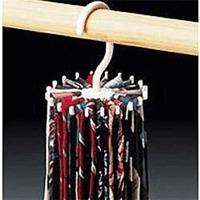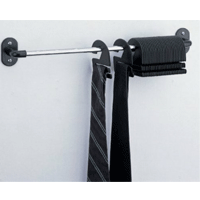Neckties are a funny thing. They're symbols of pert authority when all the way up, symbols of casualness when they're down—and when they're not there at all, on some occasions, people wonder why.
In exchange for those instant telltale signs, however, we as card-carrying necktie wearers have a duty to protect them. Since they can't tell us if we're stressing them out, need a shower or just being treated poorly in general, take a moment to learn (or relearn) some tie care basics.
Wrinkles
One of the largest problems the beginning tie-wearer faces is wrinkles. Not just random waves in the fabric, these wrinkles are persistent creases that break the line down the center of the body. This simply will not do.
Wrinkles form for a few reasons: improper storage, faulty undoing of the knot, and/or too tight a knot in the first place.
When storing a necktie, take the fabric into consideration. If it's silk, hang it up—the material has a beautiful intrinsic quality of relaxing and smoothing itself out. As delicate as silk is, it’s best if left hung up to let gravity do its work. Small wrinkles tend to fade away in the fabric if it gets the proper time to recover. This also means that, although we all have our favorites, we can't wear the same one every day.
As for cotton, wool and knit ties, our best course of action is to roll them up and store them away in a drawer. Unlike silk ties, gravity may actually damage these types of fabric, making them lose their fresh, crisp look.
The second possible cause for wrinkles is the actual act of unknotting our ties. Although it can be cathartic to take off a tie (especially if you're mad as hell, yank off your tie, throw your fedora down, and stomp on it after losing at the track), a wrinkly future is in store if it's undone improperly. To take off a tie, just reverse the steps of putting it on. It's that simple. Those few seconds are worth any price charged to dewrinkle it by a professional. As Primer style editor Grant Harris says, never try to iron a tie yourself.
Unless we're so tired we end up falling asleep without changing our clothes, there's no real excuse to disrespect our ties by not undoing them and storing them with the finesse and care they deserve… and they all deserve it. Doing so will keep your tie wrinkle-free and looking as fresh as the day you clipped it on for the first time. Just kidding. I hope.
This last point can't really be stressed enough. I'd like to say knot tightness is the main culprit of tie wrinkles, but the Pew Research Center isn't exactly compiling empirical data to back it up yet. Until that glorious day, all I have is the ole gut feelin'.
I have a friend who likes to think he knows more than anyone about menswear. Taking this as a cue he could at least be trusted to take care of a tie, I let him borrow a magnificent dark blue treasure of mine. It was returned with a crease. Right where the knot was. It was like standing at the edge of the abyss and staring into the jagged shadow of oblivion. Not wanting to be on the news for garroting a man with silk, I explained that a tie is not like a shoe. They don't arbitrarily get undone as we're going about the day, so we needn't knot them like a noose.
Storage
Although mentioned above, it's worth going deeper into how to properly put our ties up for the night.
Get a tie rack. While you can technically hang a tie off of anything, it's not worth the risk of throwing it on the back of a chair that gets sat upon and, lo and behold, getting it creased. Tie racks aren't expensive, either, so there's no excuse to not have one.
It might just be me, but the possession of a tie rack is impetus to use it. And when we use tie racks, everyone wins. Plus, silk is actually a protein fiber, which makes it susceptible to fading and damage if exposed to sunlight for too long. Keep your tie rack someplace dark and cool and dry.
If you're worried about storage in extraordinary situations—i.e. traveling—don't fret. There are indeed traveling cases out there. Don't be lured into a false sense of security, though. When you reach your destination, take time to hang or roll up your ties since they'll have been folded up the entire time they're in there. And if you're a DIY kind of guy, and just carrying a few ties, you can roll ’em up and stick ’em into a pair of shoes. Two birds with one stone!
Stain Care
After wrinkles, the other plague tie-wearers must be weary of is the dreaded blemish.
When it comes to stains, tread carefully. Damaging a tie is easy—so easy I swear even looking at one wrong may curl the tip up. Despite that, there are numerous proclaimed home remedies out there: powders, alcohol, Voodoo, yelling “Out, damned spot, out, I say!” while vigorously scrubbing it, etc. But if the stain requires meticulous work or you're worried you may damage the fabric, you may have better luck bringing it to a trusted cleaner to get the spot removed. Better safe than sorry and all.
My mother, who, with my father own a restaurant near Cincinnati, swears that lemon juice can actually remove stains from a necktie or a shirt (they get a lot of business types). While I’m not sure I’d want to risk it, her advice has never failed me yet.
If you do find yourself staring at a horrible stain, the general rules follow: blot it, don’t scrub it. Never submerge your ties in water. If you’re using a cleaning agent, test it in an inconspicuous area first (Just like carpet!).
Also, don’t “spot treat” a necktie. Any sort of difference in a tie, be it color brilliance or fabric integrity, will be immediately noticeable. It's not worth bringing attention to something we may have flubbed on as an accessory already made to attract the eye. On top of that, if the stain persists, it may even spread. Like a horrible, horrible virus.
Or you could try to steal as many Red Lobster bibs as possible to prevent it from ever happening again.




















